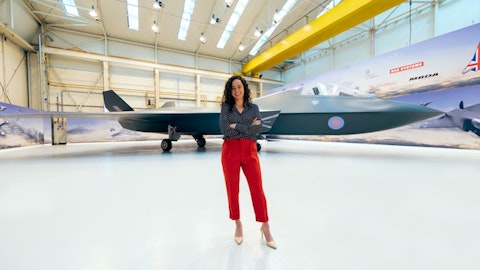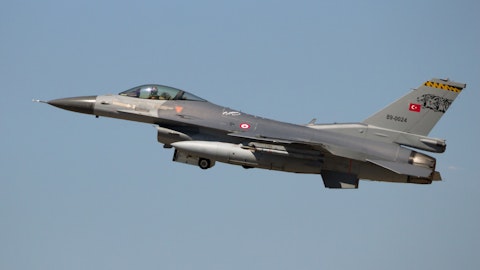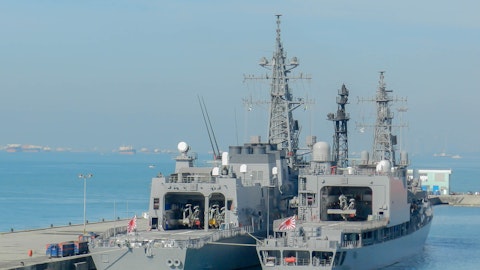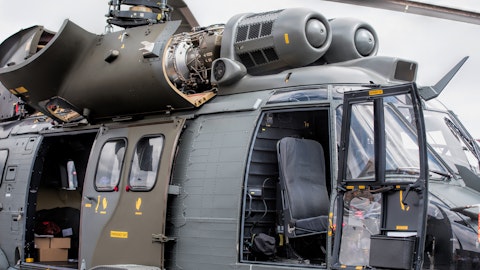Lynn Bamford: So, we have a great relationship with Westinghouse. We have a regular market update meetings with them, and we work very transparently on, what they’re seeing, what they’re bidding, et cetera. And so, they under – I think in the orders, they begin to have more security in the number of opportunities they are going to have that they’re trying to build plants in that early 2030 timeframe. I think it does put pressure for us to make sure, we can build the number of reactor coolant pumps to be in line with them to date. What we’ve shared the two to four years is still the discussion we’re having with Westinghouse. So, this isn’t really – this is a very clear discussion with Westinghouse and what they indicate. But I know we feel as we see the potential for orders and the number of plants being desired to build and know what that means for reactor coolant pumps.
We know that the order back in 2015 was for 16 RCPs between Poland and the first Bulgaria plant. That’s 15 RCPs, so that’s an order of that same magnitude. And it took us – that was initially anticipated to be a five-year bell curve of deliveries. That has us putting pumps out over a five-year plan turned into seven-year. But, so, I mean, everybody is very aware of this and really at this point we don’t want to speculate on it being earlier, but it’s clearly as, you know, the world evolves and there’s more commitment to AP1000 plants. I would say, it does put pressure on them trying to hold off. And they’re obviously and these are very costly pumps and they’re trying to control cash flow and all the things every company does. But at some point that trade-off will move to getting us started earlier, but that is still a TBD.
Kristine Liwag: I see. And then, if I recall right, the RCP for the AP1000, the same facility where you guys built the RCPs for submarines. With the two Virginia’s plus you’ve got a Columbia-class as well, which is incremental capacity. Can you remind us what the capacity is for an annual build? I mean, you’ve also had Romania and a few other countries who have put an interest in AP1000. I mean, sometimes, right, when it rain, it pours. Should all these orders come through, what’s your ultimate capacity that you could build if these orders all come in, and they all want to have a plant opening in 2030?
Lynn Bamford: So, we do have a lot of capacity to ramp up in our test with plans with, you know, adding ships and adding staff to the current ships, running two full ships, and even potentially a third ship. So, we are well-positioned with the capital footprint we have to flex up. I mean, obviously, everything, that always has a limit. One of the things we are very much in the process of evaluating is, as, you know, broadly, our content across the various SMR platforms, we very notably talks about all our content with X-energy. As their line of sight on their customers continues to grow and be positive, whether we would need to do some footprint expansions later in this decade. And so, that work is ongoing to consider if that is going to be needed.
We’re not there yet, but it’s definitely something we’re considering whether, just like we built the plant in Somerville, Curtiss-Wright is not afraid to make capital investments when you can see line of sight on important and meaningful business, and this clearly is for us. So, we were not worried about what we can produce out of the facility in Cheswick as of now. But there might be some expansion in the back half of this decade.
Chris Farkas: And I would just also add to that that. Those contracts are typically front loaded with cash, right? So, I think if there is any type of CapEx spike at this point, we wouldn’t expect it to be significant, but we would expect the cash flows on those contracts to fully help us ramp up in those circumstances. And obviously, it’s a very profitable business, so we think people would be really happy with anything that we do in that area.
Kristine Liwag: Great. Thank you. I’ll keep it at two.
Lynn Bamford: Thanks, Kristine.
Operator: We’ll take our next question from Nathan Jones with Stifel. Your line is open.
Nathan Jones: Good morning, everyone.
Lynn Bamford: Hi, Nathan.
Chris Farkas: Good morning.
Nathan Jones: I’d just like to start off with digging a bit more into the margin profile and the overall margin expansion in 2023, up 20 basis points on 8% organic growth, its not huge operating average. And I know there’s a number of puts and takes. So I’d like to dig into those a little bit more. So, maybe you could comment specifically on some of the headwinds like, CAP1000 winding down. I know you talked about additional R&D investments. So, maybe unpack that for us a little bit more and then talk about what may or may not repeat in 2024 as we’re thinking about in margin profile out there?
Chris Farkas: Yes, I think when you look at the Curtiss-Wright from an overall level, when you look at the absorption that we’re getting on in sales this year, it’s fairly in line with what we’ve said, we’ve experienced historically, which is in that 25% to 30% range. I think at the midpoint of our guide right now, we would say about 27% is incremental margin. But, as we’ve talked about a number of times throughout the year, we have so many great opportunities to invest not only through IR&D, but also contract R&D to continue this great growth trajectory that we’re on. So, when you look at just the incremental IR&D year-over-year, that’s $5 million. And as we look at the total R&D, which includes contract R&D, and we’ve talked a little bit about things like, advanced naval COTS and subsea pumps and the various development contracts that are going on within the A&I segment across the actuation, I mean, we’re going to be spending in excess of $20 million of R&D this year, and that puts a little bit of pressure on margin.



